![]()
![]()
![]()
Use LEFT and RIGHT arrow keys to navigate between flashcards;
Use UP and DOWN arrow keys to flip the card;
H to show hint;
A reads text to speech;
81 Cards in this Set
- Front
- Back
|
What is The quality in the prostheses which acts to resist forces of dislodgement along the path of placement? Resistance to removal in a direction opposite that of insertion.
|
Retention
|
|
|
What is The quality of a prostheses to be firm, steady, or constant to resist displacement by functional horizontal or rotational forces?
|
Stability
|
|
|
What is The foundation area on which a dental prosthesis rests?
|
Support
|
|
|
What is Resistance to separation of 2 parallel surfaces that are held together by a film of liquid in between them? It is dependent on the “wetability” of the surfaces.
|
Interfacial Forces
|
|
|
What has a greater wetability, processed denture base materials (heat and pressure cured in a commercial dental lab) or auto (or self) cured resins (used in chairside relines or repairs?
|
Processed denture base materials
|
|
|
The oral mucosa has a low surface tension and will _________ its contact with the denture material. Denture base materials vary in their surface tension and therefore will vary in the degree of ______________.
|
Maximize
"Wetability" |
|
|
T/F
ALL denture base materials have higher surface tensions than the oral mucosa but when in contact with the saliva, it is reduced and therefore the fluid in between maximizes its contact with both surfaces. |
True
|
|
|
What is vertical dimension?
|
The amount of separation of the maxilla and mandible at rest and when the teeth are in occlusion
|
|
|
What is established by the natural teeth when they are present and in occlusion?
|
Vertical Dimension of Occlusion
|
|
|
What is established by the amount of separation between maxilla and mandibe when relaxed?
|
Vertical Dimension of Rest
(physiological rest position) |
|
|
What are the two methods to determine the VDO?
|
Mechanical
Physiological |
|
|
* There is a difference between VDR & VDO. This dimension is?
|
2-3 mm is the average
You can have from 1-4 mm |
|
|
T/F
One of the factors involved in the retention of dentures is interfacial surface tension. The fluid film in-between the oral mucosa and the denture furnishes a retentive force by virtue of the tendency of the fluid to maximize its contact with both surfaces. It is at least equally important and perhaps more so in mandibular denture retention. |
False
This plays an important part in the retention of the upper dentures especially but not so much in the lower dentures, partly because of the amount of tissue coverage and partly because of the amount of saliva surrounding the lower dentures. On the lower dentures, this can be likened to taking 2 pieces of glass and placing a thin film of water in between them. They stick together but if they are immersed into water, they will easily separate. |
|
|
T/F
Adhesion is the physical attraction of like molecules for each other. |
False
UNLIKE Molecules |
|
|
Several tests are used to establish the VDO by means of wax occlusal rims. They are a) Judgement of overall facial support; b) Visual observation of the space between the rims when the jaws are at rest and when the occlusion rims are in contactl d) Observations when the "s" sound is enunciated accurately and repeatedly - the average "speaking space
This speaking space is not the same as the VDR. It is 1.5-3 mm on average with Class I jaw relationship. It is usually greater in Class II patients and less in Class III patients. |
True
|
|
|
One version of adhesion is observed between denture bases and mucous membranes themselves. This is most commonly seen in patients who have a condition called _______
|
Xerostomia
|
|
|
What can radiation damage to salivary glands result in?
|
Xerostomia
|
|
|
T/F
Cohesion is a retentive force because it occurs within the layer of fluid -usually saliva- that is present between the denture base and the mucosa. Normal saliva is considered to be very cohesive. |
False
Thin saliva is somewhat cohesive. Normal saliva is not very cohesive. Thick saliva has little cohesiveness. Cohesiveness is NOT a major factor in denture retention |
|
|
Complete dentures have three surfaces that must harmonize with the oral biological environment. They are:
|
1) The dentures polished surfaces
2) The impression or intaglio side of the denture base and its fit to the basal surface 3) The occlusal surfaces of one denture must fit to the occlusal surfaces of the opposing denture |
|
|
What method is described by:
Physiological rest position Phonetics Esthetics Swallowing threshold Tactile sense and patient perceived comfor |
Physiological method
|
|
|
Which method involves Pre-extraction records & Ridge ralations?
|
Mechanical methods
|
|
|
What are the Ridge relations you look for in the mechanical method?
|
1. Incisive papilla to mandibular incisors
2. Parallelism of the ridges 3. Measurement of former dentures |
|
|
What are the Pre-extraction records used for the mechanical method?
|
1. Profile radiographs
2. Diagnostic casts 3. Facial measurements |
|
|
What are some other terms for the distance between the lower and the upper teeth when the mandible is in the physiological rest position?
|
Interocclusal distance or Freeway space
|
|
|
What is the difference between the VDO and the VDR?
|
The interocclusal space
|
|
|
What should you observe while chatting with your patients for a few minutes?
|
Observe smile line, lip position & esthetics
|
|
|
Where do you mark 2 spots that are fairly stable?
|
On the tip of the nose and on the chin point
|
|
|
What are some preliminary exercises that you can have your patient do?
|
lick lips
say Mississippi, sixty six, MMMMM |
|
|
How much speaking space do you want between the anterior portions of the rims?
|
1-3 mm speaking space
|
|
|
What can you do to obtain the VDR?
|
Take a deep breath, wet the lips
M M M M |
|
|
What are words that you can have your patient say to check the speaking space?
|
Count from 60-70
say mississippi |
|
|
What determines the CR?
|
TMJ structures
|
|
|
Is CR a vertical or horizontal relation?
|
Horizontal relation
|
|
|
What is used to demonstrate terminal hinge axis?
|
CR
|
|
|
What is one of the most critical factors in mounting casts on the articulator?
|
CR
|
|
|
What is a reproducible relation?
|
CR
|
|
|
What does adhesion work to enhance the further retentive force of?
|
INTERFACIAL SURFACE TENSION
|
|
|
What is accomplished by saliva adhering to mucosa and denture base?
|
Adhesion
|
|
|
Which arch is adhesion most helpful for denture retention?
|
Maxillary
|
|
|
What condition does a patient have that produces bad adhesion?
|
Xerostomia
The denture base will stick to the dry mucosal membrane and will cause abrasions and ulcerations because of no lubrication. The dentures will also stick to the lips and cheeks. |
|
|
What is the physical attraction of LIKE molecules for each other?
|
Cohesion
|
|
|
What is the potential space between the lips and cheeks on one side and the tongue on the other, where it is the area where the forces between the tongue and cheeks/lips are equal?
|
Neutral Zone
|
|
|
Why do we use centric relation to mount lower master cast to the upper master cast?
|
CR is a reproducable and recordable
|
|
|
Centric relation in our work relates to the ______ reference position of the mandible that can be produced.
|
Horizontal
|
|
|
T/F
One of the factors involved in the retention of dentures is Interfacial Surface Tension. The fluid film in between the oral mucosa and the denture furnishes a retentive force by virtue of the tendency of the fluid to maximize its contact with both surfaces. It is at least equally important and perhaps more so in mandibular denture retention. |
False
ALL denture base materials have higher surface tensions than the oral mucosa but when in contact with the saliva, it is reduced and therefore the fluid in between maximizes its contact with both surfaces. This plays an important part in the retention of the upper dentures especially but not so much in the lower dentures, partly because of the amount of tissue coverage and partly because of the amount of saliva surrounding the lower dentures. |
|
|
What are the factors involved in the retention of complete dentures?
|
1) Interfacial Forces
2) Adhesion 3) Cohesion 4) Oral and Facial Musculature 5) Atmospheric Pressure |
|
|
T/F
Atmospheric pressure is the same as suction |
False
Suction would cause tissue damage |
|
|
What does atmospheric pressure need to be effective in resisting dislodgements of the dentures?
|
They require an effective seal around their borders
|
|
|
What depends upon:
1) Teeth placed in the neutral zone between the cheeks and the tongue 2) Polished surfaces of denture are properly shaped (concave buccally and lingually) so that the tissues will fold over them 3) Denture base is properly extended to cover the maximum area of tissue possible 4) Occlusal plane is at the correct level 5) Arch form of the teeth is within the neutral zone |
Muscles supply retentive forces provided that these conditions are met.
(oral and facial musculature) |
|
|
How cohesive is thin saliva?
|
Thin saliva = kind-of cohesive
|
|
|
How cohesive is normal saliva?
|
Normal saliva = Not very cohesive
|
|
|
How cohesive is thick saliva?
|
Thick saliva = Hardly any cohesiveness
|
|
|
On the typodonts we have given arbitrary dimensions for the upper and lower WOR. The upper rim in humans will vary in vertical length and are used to help determine the incisal edge length. This length will usually be ____ the lip line of a patient over 60 years of age
|
Above
|
|
|
When were the first pocelain teeth made?
|
1774
|
|

Which number is the shade number?
|

Top right (65)
|
|

Which number is the mould number?
|

Top Left (263)
|
|
|
What are the different factors to take into consideration for selecting denture teeth?
|
1) Material
2) Occlusal surface of posterior teeth 3) Size 4) Shape of anterior teeth 5) Shade |
|
|
What are the different materials used in denture teeth?
|
1) Acrylic resin (conventional, modified)
2) Composite + Acrylic 3) Porcelain |
|
|
What is the single cross-linked polymer that composes conventional acrylic resin?
|
PMMA Polymethylmethacrylate
(chemically bonded to the denture base acrylic) vipiDent, Biotone Dentsply |
|
|
What are the benefits of modified acrylic resin teeth?
|
Improved esthetic characteristics, color stability, better polish, highly wear resistant
|
|
|
In modified acrylic resin what composes the double crosslinked polymer?
|
IPN Interpenetrating Polymer Network
Dentsply IPN, Ivoclar Vivodent DCL, Ortholingual, Orthoplane |
|
|
What is a problem associated with Composite + acrylic denture teeth?
|
Chemical bonding may be affected
(Ivoclar NFC) |
|
|
What are two problems associated with Modified Acrylic Resin teeth?
|
Tooth debonding
Pigmentation and staining around cervical line* |
|
|
What do porcelain teeth use to attach to acrylic base?
|
Mechanical retention (diatoric or gold pins)
|
|
|
What are the the advantages of Acrylic Resin denture teeth?
|
1) Esthetic
2) Impact absorption 3) Easy adjustments 4) Chemical bond to acrylic denture base |
|
|
What are the disadvantages of Acrylic Resin teeth?
|
1) Lower chewing efficiency
2) Wear (anatomy and VDO)* 3) Technique sensitive (plaster isolation) 4) Lower color stability* |
|
|
What are the advantages of porcelain teeth?
|
1) Esthetic
2) Higher chewing efficiency 3) Higher wear resistance 4) Color stability |
|
|
What are the disadvantages of Porcelain denture teeth?
|
1) Low impact absorption
2) Wear resistance (adjustments) 3) No chemical bond to base |
|
|
What are the different types of occlusal surface shape or cusp inclines?
|
1) anatomic teeth
2) non-anatomic teeth 3) semi-anatomic teeth |
|

In Anatomic teeth, what angle is made between triangular ridge of mesio-buccal cusp of mandibular 1st molar and the horizontal plane?
|

33 degree cusped teeth
|
|
|
What type of angulation is found between Non-anatomic teeth?
|

0 degrees
Flat Cusps (patent shapes) |
|
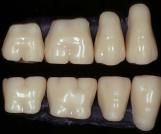
What teeth feature:
Maxillary - zero degree cusp angles, natural tooth appearance, double crosslinked resin, modified ridge lap. Mandibular - all of the above + central groove accomodates lingual contact occlusion |

SR Orthoplane Teeth
|
|
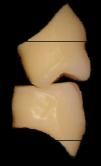
What is the cusp angulations of semi anatomic teeth?
|

< 33 deg
mostly 15 & 20 deg |
|
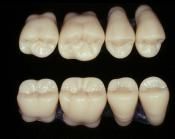
What teeth have the properties:
Maxillary - Dominant lingual cusp, Progressively decreasing buccal cusp, Full facial length of premolars, Double cross-linked resin, Modified ridge lap design. Mandibular = "" + Elimination of mesial distal interferences, 20 deg buccal cusp angles |

SR Ortholingual
|
|
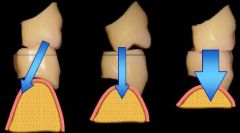
What type of teeth are on the Left?
|

Anatomic
|
|

What type of denture teeth are in the middle?
|
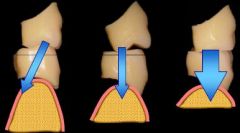
Semi-anatomic
|
|
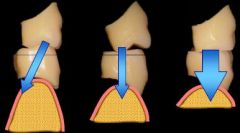
What type of denture teeth are on the right?
|

Non-anatomic
|
|
|
What are some methods of obtaining the correct size, shape, and shade of the original teeth?
|
1) Antique photograph (shade, size, alignment)
2) Dentate stone casts (anterior teeth present, shape and size, alignment of anterior teeth) 3) Related smiles (create a smile that the patient already appreciates) 4) Existing dentures |
|

How do you determine the central incisor length?
|

The high smile line
|
|
|
What are some inconsistent methods of determining correct tooth shape?
|
CI = Face width/16
6 Ant = Face width/3.3 Nasal width = intercanine distance (A.A. were way off) Center of incisive papilla determines location of canine cusp tips (most relevent to asians) Posterior border of incisal papilla = distal of canines Intercomissural width = distance between distal of canines (asians had extremely high error rate) Face shape = inverted tooth shape CI shape = shape of maxillary arch Men = bold shapes; Women = soft shapes Men = darker shades; Women = lighter shades |
|
|
What is the Psychology of acceptance?
|
Give the patient what they want
|

